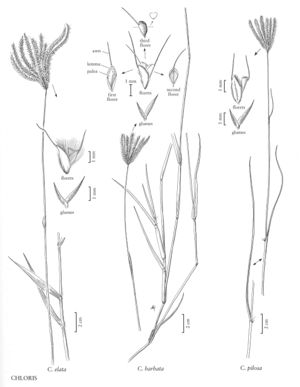Chloris barbata
Plants annual. Culms 15-95 cm, erect or decumbent and rooting at the lower nodes. Sheaths glabrous; ligules 0.3-0.5 mm, erose to lacerate; blades to 15 cm long, 0.3-0.6 mm wide, with basal hairs, otherwise usually glabrous. Panicles digitate, with 7-15 evidently distinct branches; branches 3-8 cm, more or less erect, averaging 14 spikelets per cm. Spikelets with 1 bisexual and 2(3) sterile florets. Lower glumes 1.2-2.1 mm; upper glumes 2.3-2.7 mm; lowest lemmas 2-2.7 mm, ovate to elliptic, calluses and distal portion of the margins pilose, hairs to 1 mm, keels glabrous or pilose, apices awned, awns 4-7.7 mm; second florets 0.9-1.3 mm long, 0.4-0.9 mm wide, slightly to strongly widened distally, inflated, usually glabrous, truncate, awned, awns 5-7 mm; third florets obovoid to subspherical, smaller than the first, strongly inflated. Caryopses 1.1-1.4 mm. 2n = 20, 40, ca. 50.
Distribution
Puerto Rico, Tex., La., Virgin Islands, Pacific Islands (Hawaii), S.C., Fla.
Discussion
Chloris barbata grows in subtropical and tropical coastal regions on loams, limestone-derived soils, and along beaches. The main portion of its range lies to the south of the Flora region, through the Caribbean and the east coast of Mexico, Central America, and South America. It is a weedy species, often growing in waste areas, but also in cultivated fields.
Selected References
None.
